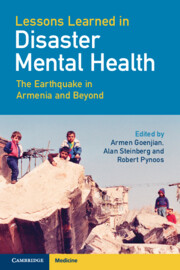Book contents
- Lessons Learned in Disaster Mental Health: The Earthquake in Armenia and Beyond
- Frontispiece
- Lessons Learned in Disaster Mental Health: The Earthquake in Armenia and Beyond
- Copyright page
- Contents
- Dedication
- Preface
- Contributors
- Chapter 1 The 1988 Spitak Earthquake in Armenia and the Implementation of the Psychiatric Outreach Program
- Chapter 2 Diaspora Therapists Working in the Earthquake Zone
- Chapter 3 Treatment Outcome among Early Adolescents Two Decades Post-Earthquake
- Chapter 4 Course and Predictors of PTSD and Depression among Not Treated Children and Adolescents over Two Decades
- Chapter 5 Conscience, Moral Injury, and Psychopathology
- Chapter 6 Natural Disasters and Relocation
- Chapter 7 Long-Term Course of PTSD and Depression Among Adults, Mediating and Moderating Factors in Recovery, and Current Trends for Treatment
- Chapter 8 How the Spitak Earthquake Contributed to our Understanding of the Genetics of PTSD and Associated Disorders
- Chapter 9 Epidemiology of Disasters and the Spitak Earthquake
- Chapter 10 Traumatic Stress Conceptual Framework
- Chapter 11 Memoirs of the Spitak Earthquake
- Chapter 12 Lessons Learned from the Spitak Earthquake and Other Catastrophic Disasters
- Index
- Plate Section (PDF Only)
- References
Chapter 4 - Course and Predictors of PTSD and Depression among Not Treated Children and Adolescents over Two Decades
Published online by Cambridge University Press: 20 May 2022
- Lessons Learned in Disaster Mental Health: The Earthquake in Armenia and Beyond
- Frontispiece
- Lessons Learned in Disaster Mental Health: The Earthquake in Armenia and Beyond
- Copyright page
- Contents
- Dedication
- Preface
- Contributors
- Chapter 1 The 1988 Spitak Earthquake in Armenia and the Implementation of the Psychiatric Outreach Program
- Chapter 2 Diaspora Therapists Working in the Earthquake Zone
- Chapter 3 Treatment Outcome among Early Adolescents Two Decades Post-Earthquake
- Chapter 4 Course and Predictors of PTSD and Depression among Not Treated Children and Adolescents over Two Decades
- Chapter 5 Conscience, Moral Injury, and Psychopathology
- Chapter 6 Natural Disasters and Relocation
- Chapter 7 Long-Term Course of PTSD and Depression Among Adults, Mediating and Moderating Factors in Recovery, and Current Trends for Treatment
- Chapter 8 How the Spitak Earthquake Contributed to our Understanding of the Genetics of PTSD and Associated Disorders
- Chapter 9 Epidemiology of Disasters and the Spitak Earthquake
- Chapter 10 Traumatic Stress Conceptual Framework
- Chapter 11 Memoirs of the Spitak Earthquake
- Chapter 12 Lessons Learned from the Spitak Earthquake and Other Catastrophic Disasters
- Index
- Plate Section (PDF Only)
- References
Summary
At 1.5- and five-year follow-ups after the Spitak earthquake, there was a significant dose–response relation between earthquake exposure and severity of PTSD and depression. The more severely exposed Spitak group had higher PTSD and depression scores than the less severely exposed group from Gumri. However, at twenty-five years, this relation had dissipated. PTSD severity of the Spitak group that had experienced comparatively fewer post-earthquake adversities (lack of heat, electricity, food, medicine, housing, transportation) and post-earthquake traumatic experiences (e.g., fights, accidents) was comparable to that of the Gumri group; while depression severity of the Gumri group, which had been significantly lower than the Spitak group at baseline, was higher at follow-up. The detrimental impact of adversities was greater for depression than for PTSD.
Risk factors for PTSD and depression at twenty-five years included adversities, baseline PTSD and separation anxiety severity, loss of home, and chronic medical illnesses. Social support by family and friends emerged as a protective factor. Compared with those who lost one parent and controls, orphans were at greater risk for clinical depression. Although there was a decrease in PTSD rates from baseline to twenty-five years post-earthquake (48% to 22%), earthquake-related PTSD remained a significant public health problem. Alleviation of adversities, improving the social ecology, and monitoring chronic medical illnesses should be considered essential components of disaster recovery programs.
Keywords
- Type
- Chapter
- Information
- Lessons Learned in Disaster Mental HealthThe Earthquake in Armenia and Beyond, pp. 48 - 72Publisher: Cambridge University PressPrint publication year: 2022

